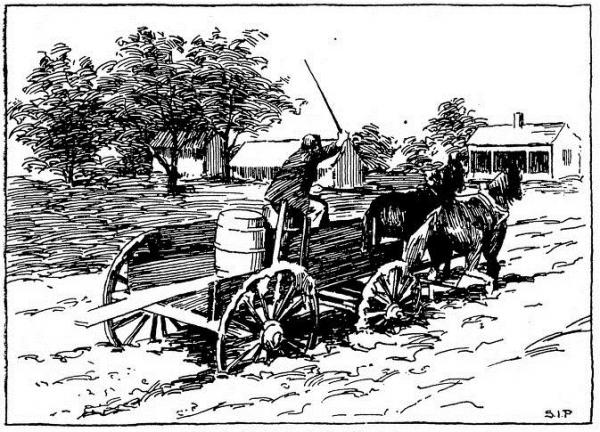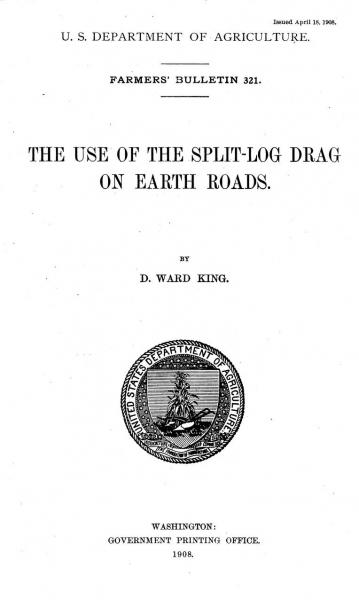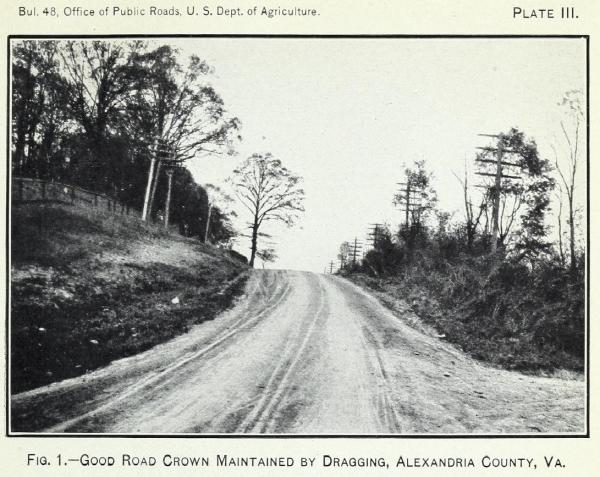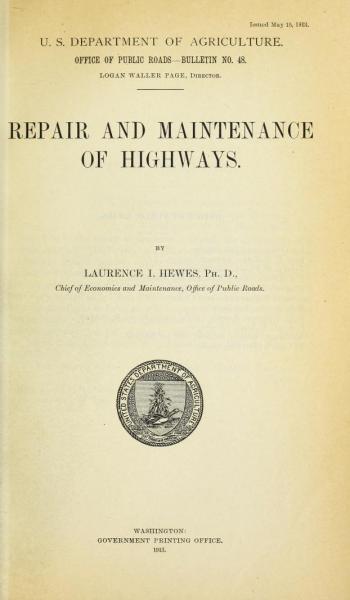
At the beginning of the year 1913, 90 per cent, or approximately 2,000,000 miles, of the roads in this country were earth. The repair and proper maintenance of earth roads are therefore of great importance.
Hewes, Laurence I. (1913). Repair and Maintenance of Highways. U.S. Department of Agriculture. Office of Public Roads. Bulletin Number 48, p. 35.
The U.S. Department of Agriculture issued publications in the early 1900s that provided guidance on the best ways to build, maintain, and improve the earth roads that were common in rural America at that time. Here is a selection from these USDA reports, along with some supplementary text, to provide a larger context.


This Farmers’ Bulletin from 1902 laid out the basic problem and condition of earth roads at the start of the century:
The condition of the common roads in this country, especially in the Middle West, is so deplorable at certain seasons of the year as to operate as a complete embargo on marketing farm products. It therefore behooves every interested citizen to know something about the location, drainage, construction, and maintenance of the earth road, and it will be the object to present in this paper the fundamental principles of earth-road construction and maintenance and to furnish instruction and advice to the road builders whose facilities are limited and who are so often supplied with only inferior materials.
Eldridge, Maurice O. Assistant Director, Public Roads Inquiries. (1902). Earth Roads. U.S. Department of Agriculture. Farmers’ Bulletin Number 136, pp. 3-4.
On April 14, 1908, patent number 884,497 was issued to David Ward King, a Missouri farmer who invented a simple and effective device that would smooth out the surface of an earth road and also push the dirt to form a “crown” in the center. This crown would act to divert rainwater to either side of the road and prevent the type of muddy surface that would impede both horse and motor-powered traffic.
The device became known as the Split-Log Drag and several USDA publications featured the device and its inventor.



King described the procedure for using the Split-Log Drag and specified its benefits in a 1908 Farmers’ Bulletin:
There are at present in this country about 2,000,000 miles of such roads, most of which must be maintained by some means more or less inexpensive. The split-log drag is of great service on roads of this class, and an increasing mileage of the rural highways of this country is being kept in repair economically and well by the use of this simple implement. It is now in use in many States of the Union and in foreign countries also, and its adoption in most localities where there are earth roads will doubtless increase. The aim in writing this bulletin has been to give a concise description of the construction of the split-log drag and the method of using it which will give the best results.
King, David W. (1908). The Use of the Split-Log Drag on Earth Roads). U.S. Department of Agriculture. Farmers’ Bulletin Number 321, p. 5.
A 1913 Office of Public Roads Bulletin praised the benefits of King’s Split-Log Drag and captioned a photograph with the text, “GOOD ROAD CROWN MAINTAINED BY DRAGGING”

Hewes, Laurence I. (1913). Repair and Maintenance of Highways. U.S. Department of Agriculture. Office of Public Roads Bulletin, Number 48, Plate III, p. 48.

A 1917 Farmers’ Bulletin was devoted solely to road drags:
When it is appreciated that of more than 2,000,000 miles of public roads in the United States only about 200,000 miles have been given a hard surface, and of these 200,000 miles approximately one-half are surfaced with gravel, the importance of every effective device for maintaining the simpler types of roads becomes readily apparent. It should be observed in this connection that a large part of our total mileage of public roads is entirely unimproved and that the drag is of little use in improving sand or clay roads which have never been crowned or drained. A much larger part, however, has been sufficiently improved to make the work of the drag effective, and it is unquestionably true that the magnitude of this part is steadily increasing.
Office of Public Roads and Rural Engineering. (1917). The Road Drag and How it is Used. U.S. Department of Agriculture. Farmers’ Bulletin, Number 597, p. 1
Malcolm Gladwell does an excellent job in summing up this innovation and explaining its ultimate importance to American agriculture specifically and the American economy generally:
The King Road Drag was a simple invention that had the effect of reducing the isolation of the American farmer, and soon that simple invention led to all kinds of dramatic changes. Ever since the Post Office was established, for example, farmers had to make the difficult trek into town to pick up their mail. In the eighteen-nineties, Congress pledged that mail would be delivered free to every farmer’s home, but only so long as rural communities could demonstrate that their roads were good enough for a mailman to pass by every day–which was a Catch-22 neatly resolved by the King Road Drag. And once you had rural free delivery and good roads, something like parcel post became inevitable. Through the beginning of the century, all packages that weighed more than four pounds were carried by private-express services, which were unreliable and expensive and would, outside big cities, deliver only to a set of depots. But if the mail was being delivered every day to rural dwellers, why not have the mailman deliver packages, too? In 1912, Congress agreed, and with that the age of the mail-order house began: now a farmer could look through a catalogue that contained many thousands of products and have them delivered right to his door. Smaller companies, with limited resources, had a way to bypass the middleman and reach customers all over the country. You no longer needed to sell to the consumer through actual stores made of bricks and mortar. You could build a virtual store!
Gladwell, Malcolm (1999). “Clicks and Mortar.” The New Yorker, December 6, pp. 106-115
The National Agricultural Library holds copies of many historical and current materials documenting the ways that the rural landscape was affected by these types of innovations. Here is an additional bulletin used in this story.

The road drag is designed to reduce ruts by paring action and to smooth and harden the surface of a traveled way, and it does both. The action of the drag involves the movement of a small quantity of earth combined with a puddling action. It is not intended to grade a road as a road grader does. When the drag cuts too deeply, the hitch may be shortened. When it slides excessively with a long hitch, weight may be added temporarily to insure some cutting. The best time to use the drag is after a rain, as the surface of a road is then soft enough to be cut easily and is in the best condition to puddle. By its capacity to move small amounts of earth toward the center, the road drag maintains the correct crown, which always tends to flatten. By its capacity to puddle the surface, the drag builds up successive thin layers of material, which gradually become waterproof and harden while drying. Dragging should begin at the outside of the road and progress toward the center. The road drag is not a cure-all for bad roads, although almost any road is helped by dragging. To secure the best results the road should be in good repair as to section and drainage, and the drag should be used often, especially in the first season. An old road, full of cobbles used to fill 'chuck' holes, can not respond to dragging. The drag should be used always when the road is wet but not so sticky that mud clings to the blades. This is often the case in the black soils of the Middle West, and a smoothing drag or slicker is used successfully in such conditions. Dragging a dry road is of no benefit. The road drag consequently is peculiarly adapted to a system of continuous road maintenance, and the annual cost is low. p. 46
 An official website of the United States government.
An official website of the United States government.